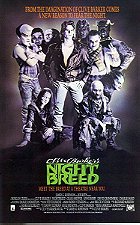
Posted : 12 years, 1 month ago on 30 November 2013 08:13
(A review of
Nightbreed)
 Nightbreed
Nightbreed was released in 1990 and is the second film directed by British horror author Clive Barker, following his 1987 film
Hellraiser. The movie was adapted from Barker's own novel,
Cabal, and is about a group of mutants and other non-human creatures who are trying to exist away from mankind, below a cemetery, in a vast underground city known as Midian. The story follows Boone, who begins having nightmares about the "monsters" living beneath the cemetery, and begins to question whether they are dreams or reality. He begins to feel that the creatures are calling him to them. His psychologist, Dr. Decker, has his own ulterior motives. The unhinged performance by David Cronenberg as Dr. Decker, is one of my favorite aspects of the film. Cronenberg, for those who don't know, is the director of such films as
Scanners,
Videodrome,
The Brood, and
Dead Ringers, to name just a few. Unfortunately, when
Nightbreed was released in theaters in 1990, 20th Century Fox decided to cut a great deal of footage from the film to make it fit into a more standard horror format of the time. Barker's original print was more epic in nature (and gorier). So far, the theatrical cut version is the only one that's ever been officially released on home video. There was a really rough looking work-print that was circulating on bootleg VHS at one point. A more thorough work-print version, called
Nightbreed: The Cabal Cut, has been screened at some festivals over the last few years. As of July 2013, it was announced that the owner of the distribution rights for the film, Morgan Creek, struck a deal with Scream Factory to fully remaster and restore the most complete version they can (depending on how much of the original film elements they can locate) for a blu-ray release, possibly in 2014. I'll be looking forward to that.

0 comments,
Reply to this entry
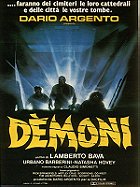
Posted : 12 years, 3 months ago on 16 October 2013 11:50
(A review of
Demons)
 Demons
Demons was produced and co-written by Dario Argento, and directed by Mario Bava's son, Lamberto Bava. Definitely one of my favorite Italian horror films. Lots of action, lots of splatter and make-up FX (by Sergio Stivaletti), and a great score by,
Goblin keyboardist, Claudio Simonetti. It also has some great songs in the movie by
Iron Maiden,
Saxon,
Billy Idol,
Mötley Crüe, and
Accept to name a few.
The basic action of the film is much like a zombie movie, only it's demons instead of zombies that are attacking people, and then once infected they also become demons. A man with half his face covered by a chrome mask, hands out fliers to a free horror movie playing at a nearby theater. By the way, the actor in the mask is Michele Soavi, who became a director in his own right, with such films as
Stage Fright,
The Church,
Devil's Daughter, and
Cemetery Man. Anyways, once all the patrons are inside the theater, one of them plays around with a demon mask prop that is on display in the lobby. She gets cut by a barb inside the mask, which later becomes infected. The movie inside the theater starts and it appears to be a horror movie where some people find a manuscript and a mask, like the one on display in the lobby, in some ancient ruins. One of them puts on the mask and gets cut by the barb inside it. Of course, they become infected, turn into a demon and attack the others. This scenario then plays out inside the theater, as the girl who put the mask on in the lobby turns into a demon and starts attacking theater-goers, who in-turn become demons and so forth. The rest of the film is a game of survival, as they find out all exits and entrances to the theater are sealed up. Lamberto Bava's best film, in my opinion, but he does have some others worth checking out too -
Macabre (aka Frozen Terror) and
A Blade in the Dark...and a somewhat fun crap-tacular
Jaws rip-off called
Devilfish.

0 comments,
Reply to this entry
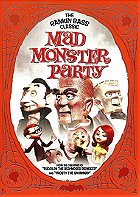
Posted : 12 years, 3 months ago on 14 October 2013 12:24
(A review of
Mad Monster Party?)
"Mad Monster Party?" was produced by Arthur Rankin and Jules Bass and released in 1967. This is a nostalgic childhood favorite of mine, as it would air on TV around Halloween back in the late '70s and early '80s. It's stop-motion animation in the same vein as other Rankin/Bass-produced holiday favorites such as "Rudolph the Red-Nosed Reindeer" and "Santa Claus Is Coming to Town", among others. They made quite a few Christmas holiday favorites, but "Mad Monster Party?" was their only Halloween-themed production. It features the voice (and animated likeness) of Boris Karloff as Baron Boris von Frankenstein, who wants to retire from the "science" business (also, he has created a matter-destroying device that has the potential to annihilate the world, and he doesn't want it to get into the wrong hands). He sends out invitations for a party - a Mad Monster Party - where he will elect his successor. Those invited include Dracula, The Invisible Man, Jekyll & Hyde, The Wolfman, The Mummy, The Hunchback and The Creature (you know, the usual people you would want to entrust with a world-destroying device)...oh, and Dr. Frankenstein's nephew, Felix Flankin, was also invited.
Harvey Kurtzman, who created MAD Magazine in 1952, co-wrote the screenplay to this movie, hence the "mad" in "Mad Monster Party".
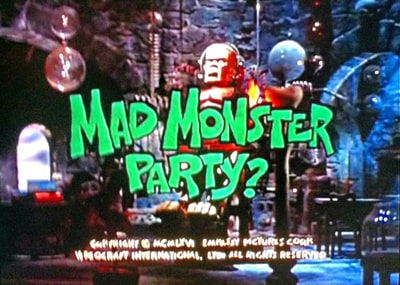

0 comments,
Reply to this entry
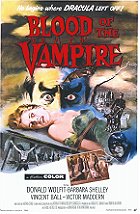
Posted : 12 years, 3 months ago on 12 October 2013 12:10
(A review of
Blood of the Vampire)

This is a British film made in 1958. It was first released in the UK in August 1958, but saw its US debut in October of the same year. The plot of this little classic horror obscurity is that a (mad?) scientist, Dr. Callistratus, with the help of his hunchbacked assistant, Carl, is conducting experiments with the blood of criminally insane prison inmates. Turns out the Doctor has a rare "blood disease", and is thought by many to be a vampire. It's an atmospheric gothic horror/thriller with shades of Dracula AND Frankenstein. "Blood of the Vampire" looks and feels very much like a Hammer Films production, and there's a good reason for this. Hammer Films veteran, Jimmy Sangster, wrote the screenplay. Just prior to this film, Sangster wrote the screenplays to two very important Hammer films - "The Curse of Frankenstein" in 1957 and "The Horror of Dracula" in 1958. These two films, along with the Italian "I Vampiri" in 1956, would spark a "gothic horror" renaissance across the world. Soon Italy's long-dead horror market would be reinvigorated. Following Riccardo Freda's "I Vampiri", the films co-director and cinematographer, Mario Bava, would go on to helm "Black Sunday" in 1960, followed by a string of other gothic horror successes. In the USA, Roger Corman was also riding the gothic horror wave with "The Fall of the House of Usher" in 1960 followed by a slew of other Poe-related films, many of them starring Vincent Price.
Getting back to "Blood of the Vampire", it was directed by Henry Cass, and is the only horror film he directed. He also directed "The Hand" two years later, in 1960, which has some horror elements but is actually a crime thriller. Another Hammer Films connection is actress Barbara Shelley, who plays Madeleine Duval in "Blood of the Vampire". She would go on to play roles in several Hammer movies, including "The Shadow of the Cat" (1961), "The Gorgon" (1964), "Dracula: Prince of Darkness" and "Rasputin: The Mad Monk" (both 1966), and "Five Million Years to Earth" (1967). Finally, a note about the VHS release of "Blood of the Vampire". It was released in 1978 by Magnetic Video Corporation, the first distributor of VHS and Beta tapes in the USA, and it has the distinction of being the first horror movie ever released on those formats; and quite possibly the first horror movie released on any home video format (as there were a couple of short-lived home video formats before VHS and Beta, such as Cartrivision).

0 comments,
Reply to this entry
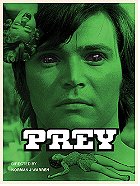
Posted : 12 years, 9 months ago on 26 April 2013 12:38
(A review of
Prey)
Alien Prey, released in 1978, was UK horror/sci-fi director Norman J. Warren's fifth film. Warren began directing soft core films with Her Private Hell and Loving Feeling, both released in 1968, before moving to horror with Evil Heritage in 1976, followed by Terror in 1978. Most people seem to either love or hate the films of Norman J. Warren. I happen to love them. Yes, they're made on the cheap, but they have a certain charm all their own, much like the films of Andy Milligan. Of the handful of Warren's films that I've seen, Alien Prey is my favorite, and can certainly be appreciated by those who aren't necessarily a fan of the director.
The premise of the film involves an alien who, after landing on Earth, subsequently kills and takes the form of a human male named Anderson. In this guise he begins his mission, which is basically to observe humans and scout the planet for "protein". He soon makes his way to the secluded house of lesbian couple, Jessica and Josephine. "Anderson" is invited in by Jessica, who has been longing for some company. Josephine reluctantly agrees, and the rest of the movie takes place here in the house and the surrounding property, as "Anderson" tries to assimilate all that he can about humans from the two girls.
Warren does a great job of juggling many different elements from horror, sci-fi, and exploitation to genuine creepiness, brief but splattery gore, and effective tension. It was released on VHS in the US by Comet Video (a subsidiary of Continental Video) in 1984 in a "big box". And it's one of my favorite Comet boxes too, up there with Herschell Gordon Lewis' "Blood Trilogy"; and like those boxes, its cover art features a juicy gory bit from the movie. It certainly attracted my attention back in the late '80s, when I first rented it from a local "mom & pop" video store. Some other films by Norman J. Warren that I enjoyed are Horror Planet (aka Inseminoid) and Bloody New Year.

0 comments,
Reply to this entry
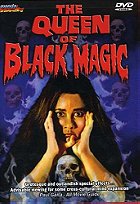
Posted : 12 years, 9 months ago on 14 April 2013 03:33
(A review of
The Queen of Black Magic)
Black Magic Terror (aka Queen of Black Magic) was directed by the prolific Indonesian filmmaker Liliek Sudjio in 1983. He had already directed quite a few films before this one, the earliest dating back to 1957. And he dabbled in all kinds of genres including drama, action, war, superheros, and horror. I've only seen Black Magic Terror, and I'm not sure how many of his other films (if any) are dubbed in English or subtitled. I would love to see some of his other films though, especially the superhero stuff like Gundala Putra Petir (Gundala The Son of Lightning) and Darna Ajaib (Darna Wonder Girl).
Synopsis (from the Twilight Video VHS release):
"In this horrifying tale, the darkest witchcraft is
woven to create terrifying demons to attack the body,
mind and spirit of its victims.
Evoking these evil spells is the Queen of Black Magic
whose anger is matched only by her powers,
her passion matched only by her hate."
Black Magic Terror carries on the tradition set forth by Hong Kong cinema's "black magic" sub-genre, which began with the Shaw Brothers production Black Magic (Jiang Tou) in 1975, and followed by such films as The Boxer's Omen, Seeding of a Ghost, and Devil Fetus to name a few. These Hong Kong-based "black magic" films are well known to western audiences who love foreign horror and cult films, but the genre actually goes farther back. There's a Hong Kong/Indonesian/Malaysian co-production from 1967 called Penanggalan (aka The Headless Terror), directed by Tulsi (Darwaza) Ramsay, and starring Indonesian actress Suzzanna as the "penanggalan". In Southeast Asian folklore a penanggalan is a being who, either through the use of black magic or by being cursed by a black magician, could detach its head from its body and the disembodied head, with entrails dangling from the spinal cord, could then fly around seeking victims. Hence the English translation of the Penanggalan film, The Headless Terror. All this would be great practice for Suzzanna, who would go on to become Murni, the "Queen of Black Magic", in Sudjio's Black Magic Terror. And one of my favorite scenes in Black Magic Terror also features a penanggalan. After being cursed by Murni's black magic, a victim proceeds to rip his own head off, complete with dangling spinal cord, which then flies around biting people. Awesome! I also love the shots of Murni training in the ways of black magic by doing flips (presumably from a trampoline that's not seen in the shot) against a midnight sky with a huge yellow full moon in the background. Murni's instructor in the dark arts is played by W. D. Mochtar, who also starred with Suzzanna in the previously mentioned movie Penanggalan (The Headless Terror). Another movie Mochtar was in that features the craziest use of the penanggalan folklore was Mystics in Bali.
Black Magic Terror was distributed in the US in 1985 by Twilight Video, which was owned by Trans World Entertainment. The DVD was released in the US by Mondo Macabro, under the title The Queen of Black Magic, in 2008. Unfortunately, 2008 also marked the passing of lead actress Suzzanna due to complications from diabetes.
In closing, I would highly recommend the film to those who love the "black magic" sub-genre, Asian cult cinema, and psychotronic film lovers in general.

0 comments,
Reply to this entry

Posted : 13 years, 6 months ago on 1 July 2012 07:28
(A review of
Anglo-Saxon Sagas and Songs)
Anglo-Saxon Sagas and Songs by Christopher Webster is a modern collection in which the author weaves his own tales around existing fragments of classic Anglo-Saxon poetry like Widsith, Deor, Waldere, and the Finnsburg fragment. It was better than I thought it was going to be. The author obviously knows his Anglo-Saxon literary history; and with some of his tales (or songs) he even attempts to emulate the alliterative verse pattern found in classic Anglo-Saxon and Scandinavian works such as Beowulf and The Poetic Edda. The contents are as follows:
Skald (a story based on the Finnsburg fragment
Hengest's Last Battle (an epic poem in alliterative verse, based on Layamon's Brut)
Frodo, Dragon Slayer (a story based on an adventure found in Saxo Grammaticus' Gesta Danorum)
The Lay of Beow (an epic poem in alliterative verse, based on a legendary hero known as Beow who was mentioned in Beowulf and Saxo Grammaticus' Gesta Danorum)
Starkath (a story based on the legendary Germanic warrior Starkath, who was written about in Saxo's Gesta Danorum)
The Lay of Ingeld (an epic poem in the alliterative verse styles of fornyrdislag and ljodahattr, used in The Poetic Edda. It's based around the same events of the Starkath story above)
Angles Against Arthur (a story based around King Arthur trying to keep the Angles out of Britain, told from the Angles point of view. The source for the story is Layamon's Brut)
King Alfred Burns the Cakes (a humorous poem in rhyming verse, based on the legend of King Alfred burning the cakes at Butterbusk farm in Conisbrough)
Haldane of Doncaster (a story pieced together from bits of information in The Anglo-Saxon Chronicle and The Chronicle of Piers Langtoft)
The Lay of Ellendune (a poem in alliterative verse, based on a fragment from the lost Anglo-Saxon poem Lay of Ellendune)
The Battle of Maldon (a story based on an existing Anglo-Saxon poem of the same name. The author has reconstructed the missing beginning and end of the poem using information from The Anglo-Saxon Chronicle)
Thormod the Skald (a song based on the "Thomas the Rhymer" ballad, where the author has changed the name Thomas to the more Anglo-Saxon Thormod and also changed the verse from rhyming to alliterative)
The Saga of Sigurd (a story based on the events following the historical Battle of Hastings in 1066, which marked the Norman conquest of England and the end of Anglo-Saxon rule)
Epilogue

0 comments,
Reply to this entry
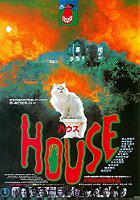
Posted : 14 years, 11 months ago on 3 February 2011 09:06
(A review of
House)
Once upon a time, the gang from Scooby Doo met Mario Bava and Salvadore Dali in an old dark house somewhere in Japan...and they said, "Zoinks! Like, let's make a movie, man!" Then the Cheshire Cat strolled in, eyes flashing green, grinning from ear to ear, with a sack full of shrooms saying, "I'm the f**cker with the bag of trips that's gonna hold this absurd concoction together!". This movie is the document of that madness. Amazing!

0 comments,
Reply to this entry
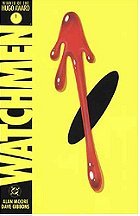
Posted : 15 years, 7 months ago on 15 June 2010 01:23
(A review of
Watchmen)
I first read Watchmen when it was originally released in monthly installments, consisting of 12 issues back in 1986/87, and it blew my mind. I eagerly awaited each issue like I never had any comic before. At the time, I had pretty much given up on superhero comics and mainstream publishers like Marvel and DC, in favor of independent publishers. However, all that changed when I read Alan Moore's Watchmen. He injected reality, social commentary, and humanity (at it's best and worst) into the stagnant superhero market, at a time when DC and Marvel Comics' superheroes were becoming stale and redundant (at least in my opinion). I think Moore realized this too and decided to deconstruct the superhero myth. In the alternate history world of Watchmen, costumed vigilantes have been replaced with government-sanctioned "superheroes", who all share a rather bleak and nihilistic view of their world which perfectly reflected the tension, fear and paranoia of Reaganite America. The threat of nuclear armageddon was a very real possibility. After all, there are no real "supervillains" left in the world of Watchmen, so the only people they have to struggle with is society and themselves. The flow and structure of the non-linear plotline was also groundbreaking at the time (as far as comics were concerned). Now let's talk about the art. Who could ever forget the blood-stained smiley, a truly iconic image, which appears and reappears strategically throughout the story, along with other minute visual details and symbols that add to the plot. The combination of Dave Gibbons' artwork with John Higgins' colors was perfect, creating a natural flow with Moore's story. The art is rich and detailed, yet simple enough not to overload the brain with TOO much visual stimulation. So it does what truly good comic book art should do - aid the reader's enjoyment of the story, rather than overpowering it. And what a superbly crafted story it is. Of course, there are those who read superhero stories purely for escapism and don't appreciate reality slapping them in the face when they read a comic book. But as far as I'm concerned, writers like Alan Moore, Frank Miller and Neil Gaiman were the greatest thing to happen to the mainstream comic market. They brought forth serious, darker, and more realistic stories; but more importantly the skill with which they crafted the stories and adapted them to comic book/graphic novel format insured they would be read, re-read, and reprinted for generations to come. It was largely thanks to the 1987 graphic novel collection of Watchmen, along with Frank Miller's Batman: The Dark Knight Returns the previous year, which really brought the graphic novel format forward, for better or worse. And I say "for better or worse" because the downside of this is that nowadays any comic book publisher can throw together a collection of crap in a trade paperback format, release it as a "graphic novel", and it somehow becomes more acceptable and commercially viable. But I digress, the above statement has nothing to do with Watchmen, which is pure gold, and should be purchased by anyone who enjoys a good story that really engages the reader!

0 comments,
Reply to this entry
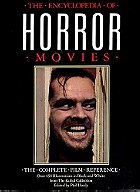
Posted : 15 years, 10 months ago on 4 March 2010 11:33
(A review of
The Encyclopedia of Horror Movies: The Complete Film Reference)
This book, along with Chas Balun's Deep Red Horror Handbook, was my Bible during the '80s video boom, which is when I became obsessed with horror movies. I bought this brand new when it came out in 1987 and it's been completely indispensable to me ever since. It's a hefty tome, about one inch thick, with that one inch being comprised of over 400 pages. Unfortunately, the cover is laminated paperback and the book has seen a lot of use over the years. However, the binding is very sturdy and there are no lose pages. The cover may be creased and worn but the laminate has managed to keep it in one piece.
As for the contents, there's a Preface written by editor Phil Hardy, followed by an article entitled "The Horror Film In Perspective" which traces the origins of the horror film from the silent era on through the '70s. Then we get to the "meat and potatoes" of the book - plot synopses and critical reviews for over 1300 horror movies, covering films from countries all over the world. And they're broken down into chapters listed chronologically by decade, covering a period of time from 1896 to 1985. This is followed by four Appendices. Appendix 1 is a list of top-grossing horror video rentals. Appendix 2 is a list of critics top 10 horror films. Appendix 3 is a list of horror films that won or were nominated for Oscars. Appendix 4 is a select bibliography of works cited in the book. There's also an excellent (and very useful) Index where you can look up a movie by its original title or any known alternate title it may have went by.
This reference book helped me immensely during my horror-finding video store adventures in the '80s and early '90s. I can't stress how important a book like this was during the era before the internet. Of course, today all you have to do is log on and go to imdb.com (or listal) to find out all kind of info about pretty much any movie you want (and in some cases just search for a bit-torrent, download it and actually watch the movie). But being a horror fan in the '80s meant you had to rely on reference books like this one and magazines like Fangoria, Gorezone, and Deep Red in order to find information about underground, obscure, cult, or international horror films. There was no other way. One of the things that was so great about this book was that it lists foreign films under their original title, followed by all other titles that it goes by in other countries, as well as pseudonyms the director may have used. As would often happen in the '80s, some video distributors would change the names of the credits on foreign films to make it look like an American film. So Lucio Fulci might become "Luis Fuller" etc. Using the feature of this book that I listed above, I was able to find many of these "hidden" foreign films. This feature is not as relevant today (unless you're a VHS collector), because most DVD distributors that are are releasing horror films today actually care about their product and don't need to "hide" them in this manner by making them look like domestic movies.
Now comes the question. Do you, as a horror fan, NEED to have this book? I would say no, at least not as a reference book, which is its main purpose. Why? Because you can go to the internet for all that info, and because this book is limited in its scope, only covering movies made up to 1985 (when it was printed). Having said that though, would I ever part with it? Absolutely not! I still crack this baby open at least once a week to look up something. And besides, I respect the highly informative and intelligently written critical reviews of the films, as well as the sense of nostalgia that I get nearly every time I pick it up.

0 comments,
Reply to this entry

 Login
Login
 Home
Home 64 Lists
64 Lists 52 Reviews
52 Reviews Collections
Collections
 0 comments,
0 comments, 










